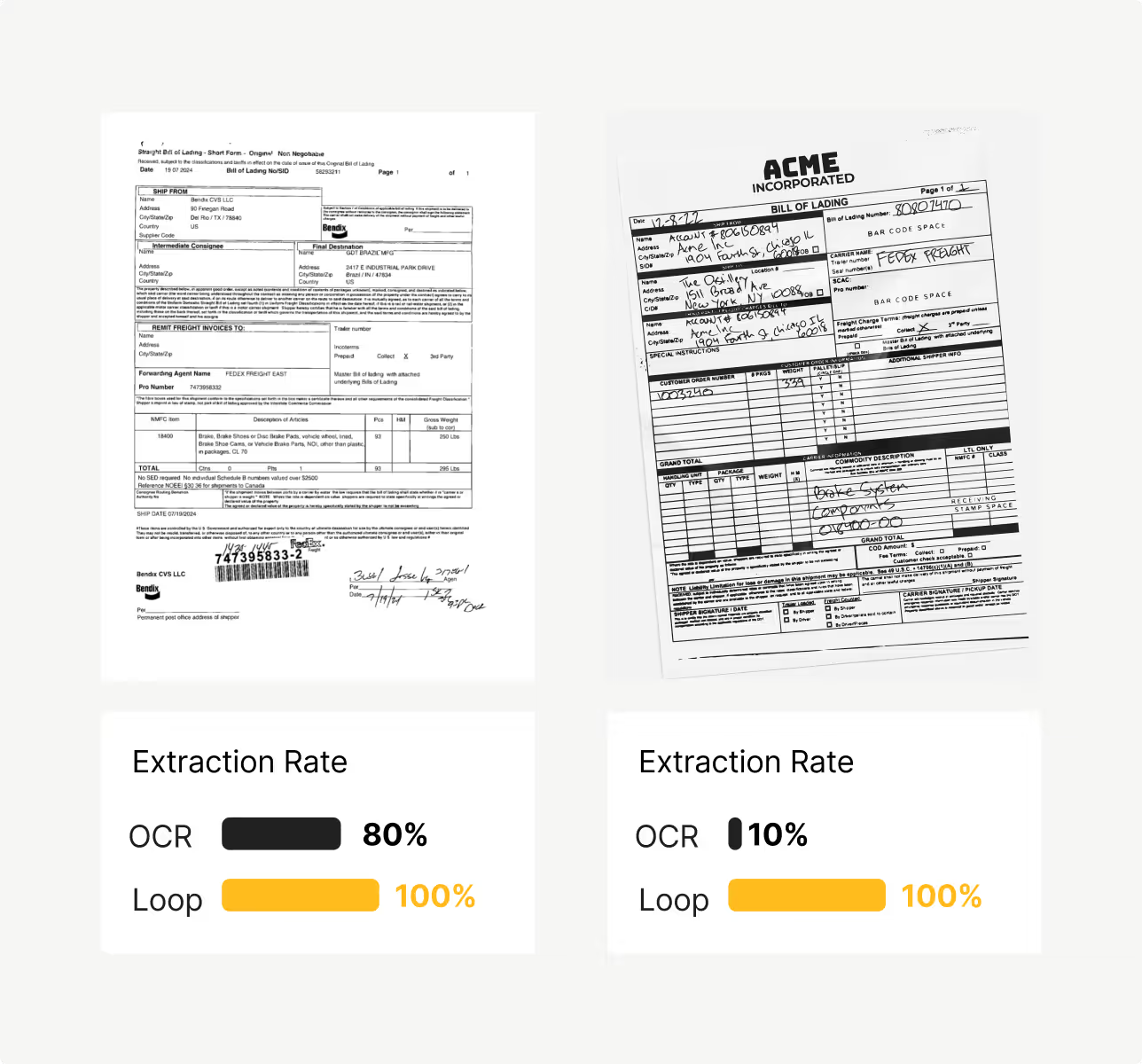Meet DUX: The first logistics AI model
Custom architected to extract granular data from transportation documents, DUX™ creates a complete, trustworthy picture of every shipment. Using that high-quality data to fuel accurate, touchless audits, we move supply chain teams from reactive exception management to proactive optimization.

































How DUX works
DUX™ is the core of our multi-step process to transform raw transportation documents into a pristine data asset. This journey from chaos to clarity follows four key steps, moving from any transportation document to a powerful foundation for intelligence.

Step 1: Document ingestion
Connect the Loop platform to a wide range of transportation documents in any format, from a multi-page freight invoice PDF to a scanned bill of lading with handwritten notes.

Step 2: Document classification
Our AI classifies what each document is—an invoice, a contract, a customs form—ensuring it’s routed to the correct models for context-aware processing.

Step 3: Data extraction
DUX’s industry-first LLM capabilities combine advanced OCR with deep context awareness to capture detailed text, stamps, and handwritten notes to create a structured, high-quality data foundation.

Step 4: Linking & Normalization
Loop AI models along with custom AI agents get to work, normalizing addresses, classifying charges, and linking every related document to create a complete, trustworthy audit trail for each shipment.
Legacy FAP suffers from a fundamental data problem
For too long, the supply chain has run on a foundation of messy, disconnected data. Critical information needed for optimization is locked away in a chaotic mix of EDI feeds, PDF invoices, bills of lading, and proofs of delivery.
Legacy systems and standard OCR technologies fail to capture the full picture, leading to manual data entry, costly errors, and an endless cycle of exceptions. This forces your team to spend 90%+ of their time cleaning data instead of finding savings, optimizing networks, and supporting strategic initiatives.


The solution: An AI model built for logistics
DUX™, which stands for Document Understanding and Extraction, is the first logistics-native AI model built from the ground up to solve the messy transportation data challenge.
Unlike generic, bolted-on LLMs, DUX is a first-of-its-kind architecture designed by Loop AI engineers and trained on hundreds of millions of real-world supply chain documents. It doesn't just read text; it understands the unique context, layout, and language of logistics, creating a perfect "digital twin" of your transportation network and unlocking unprecedented opportunities for optimization and cost savings.
DUX built with industry-first capabilities
DUX achieves unparalleled accuracy by understanding documents like a human expert, seeing the entire picture, not just the text. Unlike other frontier models, DUX processes high-resolution images, allowing it to read the fine print, stamps, and notes standard OCR misses.
Another industry-first, DUX treats visual layout and bounding boxes as critical information. This allows it to intelligently interpret the relationship between fields, complex tables, and even handwritten notes—context completely lost on text-only models.

Not a generic LLM
We get much higher accuracy training and fine-tuning our own logistics-focused AI models. Generic API based models, like ChatGPT, cannot handle supply chain tasks with enough precision and speed.

Human in the loop approach
When we build a new model, we always construct and train it with three humans involved so we can validate its performance.

Multi-model decision making
To arrive at a decision, Loop utilizes multiple models, general-purpose models and fine-tuning models to ensure there is consensus.

Atomic task system
A system that breaks down goals into smaller, manageable atomic tasks so our platform can automate work.

Computer visions models
Our models that take in image inputs and convert them to text outputs.

Large language learning models
Our homegrown models that take in text inputs to understand their context and meaning to create outcomes.

Data categorization
Identify each document type to validate it and ensure compliance.

AI-driven extraction
Configure your extraction and validate with human oversight to ensure accuracy.

Data standardization
Normalize data from every carrier regardless of how they name their service-levels, detail their line-hauls, or write “fuel surcharge” for “fuel,” “FL Sur”, “FS,” etc.
Frequently asked questions

Loop AI is built for the supply chain’s domain and language, so it can contextualize, categorize, extract, and standardize each data point to automate work and uncover insights. Our homegrown models can ingest all supply chain information regardless of systems, structures, standards, formats, terms, quality, etc.
Most importantly, it is trained on your data so it becomes more accurate and efficient as your network evolves and grows. Loop AI constructs a comprehensive, yet, flexible view so it can automate your work and analyze your business at any level.
At Loop, we use a multi-model approach including large language models (LLMs), computer vision and humans to come to a consensus so you always have accurate data.

True logistics AI is contextualized to your supply chain so you can get a comprehensive view of your supply chain and cost data. Breaking down this data into fundamental components means you can automate your work and uncover insights, at any level. Whether it’s uncovering a facility that needs new scale or adjusting service-levels to keep performance, but cut costs.

Data acquisition: flexible integrations enable our AI to centralize data regardless of source and format.
Data management: logistics-AI categorizes, extracts, and standardizes all shipment and invoice data.
Data transformation: easily link shipment data across carriers and documents to ensure consistency and accuracy.
Audit and pay: automate 99% of your invoice audit and pay with 100% financial accuracy.
Analytics: Loop offers you out of the box and customizable reports so you can uncover insights at an invoice, team, carrier, and network level.

We use a combination of computer vision and large language models (LLMs) to extract data from documents supporting an invoice. Our models are always trained by humans in their early days, as they become more mature, we introduce a multi-model consensus approach. Results are fed back into the model for improved accuracy over time.
Additionally, our human customer success team is available to help you throughout your journey at Loop. Their supply chain expertise means you can rely on them to answer any questions your AR, AP or transportation teams may have.

We have a team of stellar AI engineers who are continually investing in new ways to expand and improve Loop's AI solutions. Learn more about making sense of AI in a rapidly evolving supply chain here.
Unlock profit trapped in your supply chain.
Chat with our team of supply chain and automation experts to get started today.








